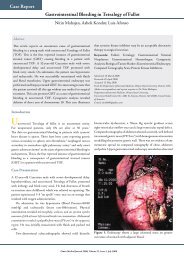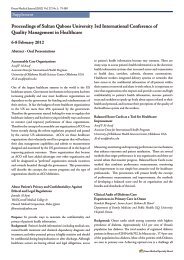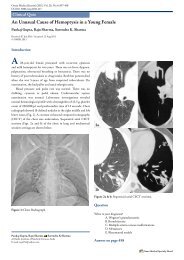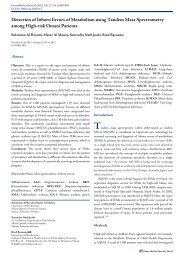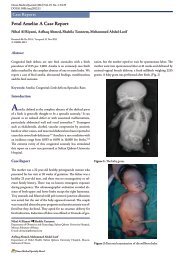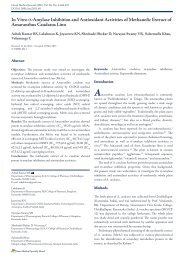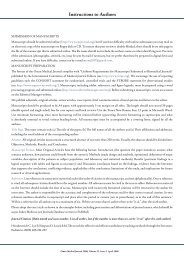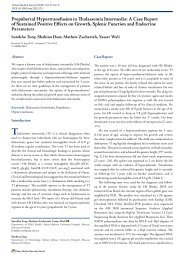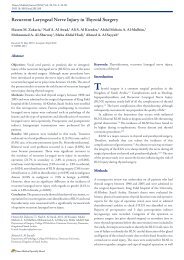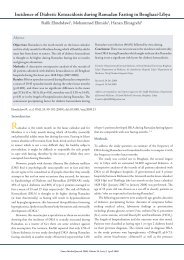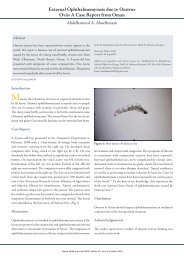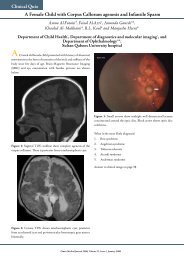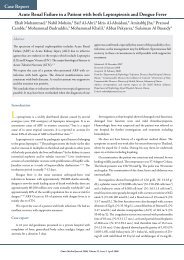A Case Report - OMJ
A Case Report - OMJ
A Case Report - OMJ
You also want an ePaper? Increase the reach of your titles
YUMPU automatically turns print PDFs into web optimized ePapers that Google loves.
Oman Medical Journal (2012) Vol. 27, No. 5: 411-412<br />
normal, (Fig. 2). The patient was discharged from hospital in an<br />
ambulatory state. He was advised to continue antiretroviral drugs<br />
and anticonvulsants. Trimethoprim-sulfamethoxazole was started<br />
(prophylactic dose) after following a sulfa desensitization protocol.<br />
He has been asymptomatic for the past 9 months.<br />
intravenous clindamycin (600 mg thrice daily) for 3 weeks. Yapar<br />
et al. 8 have used clindamycin alone to treat cerebral toxoplasmosis<br />
but it took 10 months for complete radiological clearance of the<br />
lesions. While Roemer et al. 9 used clindamycin to treat a patient<br />
with cerebral toxoplasmosis but the patient died. The potential<br />
use of clindamycin as a single agent has not been established in<br />
randomized clinical trials. The patient in this case showed good<br />
clinical improvement within 48 hours and the lesion resolved<br />
completely within 3 weeks. A positive response to treatment can be<br />
demonstrated both clinically and radiologicaly. Patil et al. 10 repeated<br />
CT scan after 21 days of treatment to demonstrate response to<br />
antitoxoplasma therapy. Beraud et al. 11 used clinical and radiological<br />
criteria to demonstrate response to treatment.<br />
Conclusion<br />
Cerebral toxoplasmosis can be treated with clindamycin without<br />
pyrimethamine in resource poor settings countries and in patients<br />
who do not tolerate sulfa drugs.<br />
Acknowledgements<br />
Figure 2: CT scan after 21 days of treatment.<br />
Discussion<br />
Human infection occurs via oral or transplacental route. The<br />
major clinical features of cerebral toxoplasmosis are headache,<br />
hemiparesis, speech disturbances, cerebellar dysfunction and cranial<br />
nerve palsies.<br />
CT scan typically reveals bilateral, multiple, hypodense ringenhancing<br />
lesions with surrounding edema in 60% to 70% of patients.<br />
Lesions can be solitary in 27% of patients. 3 The patient had a solitary<br />
lesion. If the CT scan is normal during initial screening, MRI is<br />
recommended because it is more sensitive and will detect additional<br />
lesions in some cases. 4 The patient had financial problems so MRI<br />
brain was not done. In addition to toxoplasmosis, the differential<br />
diagnoses of single or multiple enhancing mass lesions in the HIVinfected<br />
patient include primary CNS lymphoma, tuberculosis, and<br />
fungal or bacterial abscesses. About 97% of patients with cerebral<br />
toxoplasmosis have toxoplasma IgG antibodies and the levels are<br />
usually over 1:256. 5 IgG antibody levels in this patient were 326 IU/<br />
mL.<br />
Cerebral toxoplasmosis is generally treated empirically in<br />
AIDS patients with compatible neuro-imaging studies and positive<br />
serology. Brain biopsy should only be considered in patients with<br />
negative toxoplasma serology and who do not respond to treatment. 6<br />
Trimethoprim/sulfamethoxazole is an alternative treatment for<br />
toxoplasma encephalitis because it is inexpensive and as effective<br />
as pyrimethamine-sulfadiazine, 7 which is the first line drug. At<br />
our centre, we use trimethoprim/sulfamethoxazole to treat AIDS<br />
associated cerebral toxoplasmosis. Pyrimethamine alone is available<br />
only in a few institutions in India and it was not used in this patient.<br />
The patient had a history of sulfa allergy so he was treated with<br />
The authors reported no conflict of interest and no funding was<br />
received in this work.<br />
References<br />
1. Shankar SK, Mahadevan A, Satishchandra P, Kumar RU, Yasha TC, Santosh<br />
V, et al. Neuropathology of HIV/AIDS with an overview of the Indian scene.<br />
Indian J Med Res 2005 Apr;121(4):468-488.<br />
2. Dannemann B, McCutchan JA, Israelski D, Antoniskis D, Leport C, Luft<br />
B, et al; The California Collaborative Treatment Group. Treatment of<br />
toxoplasmic encephalitis in patients with AIDS. A randomized trial comparing<br />
pyrimethamine plus clindamycin to pyrimethamine plus sulfadiazine. Ann<br />
Intern Med 1992 Jan;116(1):33-43.<br />
3. Porter SB, Sande MA. Toxoplasmosis of the central nervous system in the<br />
acquired immunodeficiency syndrome. N Engl J Med 1992 Dec;327(23):1643-<br />
1648.<br />
4. Ciricillo SF, Rosenblum ML. Use of CT and MR imaging to distinguish<br />
intracranial lesions and to define the need for biopsy in AIDS patients. J<br />
Neurosurg 1990 Nov;73(5):720-724.<br />
5. Skiest DJ, Erdman W, Chang WE, Oz OK, Ware A, Fleckenstein J. SPECT<br />
thallium-201 combined with Toxoplasma serology for the presumptive diagnosis<br />
of focal central nervous system mass lesions in patients with AIDS. J Infect 2000<br />
May;40(3):274-281.<br />
6. Mathews C, Barba D, Fullerton SC. Early biopsy versus empiric treatment<br />
with delayed biopsy of non-responders in suspected HIV-associated cerebral<br />
toxoplasmosis: a decision analysis. AIDS 1995 Nov;9(11):1243-1250.<br />
7. Torre D, Speranza F, Martegani R, Zeroli C, Banfi M, Airoldi M. A<br />
retrospective study of treatment of cerebral toxoplasmosis in AIDS patients with<br />
trimethoprimsulphamethoxazole. J Infect 1998;17:15-18 .<br />
8. Yapar N, Erdenizmenli M, Oğuz VA, Cakir N, Yüce A. Cerebral toxoplasmosis<br />
treated with clindamycin alone in an HIV-positive patient allergic to<br />
sulfonamides. Int J Infect Dis 2005 Jan;9(1):64-66.<br />
9. Roemer E, Blau IW, Basara N, Kiehl MG, Bischoff M, Günzelmann S, et al.<br />
Toxoplasmosis, a severe complication in allogeneic hematopoietic stem cell<br />
transplantation: successful treatment strategies during a 5-year single-center<br />
experience. Clin Infect Dis 2001 Jan;32(1):E1-E8.<br />
10. Patil HV, Patil VC, Rajmane V, Raje V. Successful treatment of cerebral<br />
toxoplasmosis with cotrimoxazole. Indian J Sex Transm Dis 2011 Jan;32(1):44-<br />
46.<br />
11. Béraud G, Pierre-François S, Foltzer A, Abel S, Liautaud B, Smadja D, et al.<br />
Cotrimoxazole for treatment of cerebral toxoplasmosis: an observational cohort<br />
study during 1994-2006. Am J Trop Med Hyg 2009 Apr;80(4):583-587.<br />
Oman Medical Specialty Board



